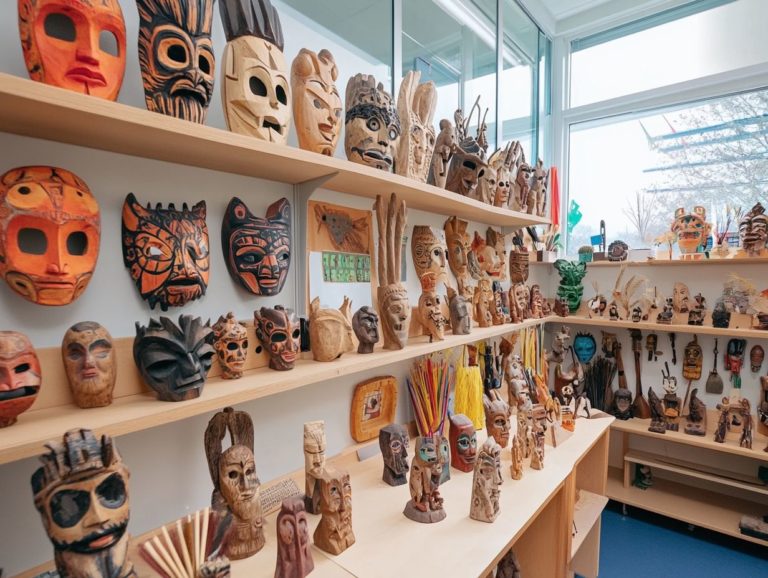the significance of cultural context in communication
Understanding the role of cultural context in communication is essential in today s interconnected world. Let s dive into how cultural nuances shape your interactions, emphasizing the significance of defining cultural context and its impact on effective communication.
Barriers like language differences and stereotypes can obstruct your understanding. Therefore, strategies for enhancing cross-cultural communication will be discussed.
You ll also discover how cultural context impacts business relationships. Navigate these crucial aspects of communication in diverse environments and elevate your interactions to a new level.
Contents
- Key Takeaways:
- The Role of Cultural Context in Communication
- Barriers to Effective Communication in Different Cultural Contexts
- Strategies for Communicating Across Cultural Contexts
- The Importance of Cultural Context in Business Communication
- Frequently Asked Questions
- What is the significance of cultural context in communication?
- How does cultural context affect communication?
- Why is it important to consider cultural context in communication?
- How can one become more aware of cultural context in communication?
- What are some potential challenges of cultural context in communication?
- How can we navigate cultural differences in communication?
Key Takeaways:
Here are the essential points to remember:

Cultural context plays a crucial role in communication, as it shapes our perceptions, values, and behaviors.
Barriers to effective communication in different cultural contexts include language differences, misunderstandings, and stereotypes.
To communicate successfully across cultural contexts, it is essential to develop cultural competence, which is the ability to communicate effectively with people from different cultures, and adapt one’s communication style accordingly.
The Role of Cultural Context in Communication
Cultural context influences communication dynamics, impacting how messages are crafted and interpreted across various cultures.
In high-context cultures such as Japan and China, communication leans heavily on non-verbal cues and the context surrounding the conversation. In contrast, low-context cultures like the United States and Australia prioritize direct statements and explicit information.
This difference shapes interpersonal relationships and professional interactions. Hence, cultural awareness and sensitivity to customs, along with a thorough audience analysis, are vital.
Defining Cultural Context
Cultural context encompasses the intricate frameworks of values, beliefs, and practices that shape communication styles and interactions across different cultures. This ultimately influences how messages are interpreted and conveyed.
This rich backdrop includes elements like language nuances, social norms, and historical influences, all contributing to the clarity and effectiveness of expression.
For example, in collectivist cultures, speakers may prioritize group harmony over individual opinions, leading to communication that is often indirect or nuanced.
On the other hand, individualistic cultures promote open and straightforward dialogue, where expressing one s viewpoint is regarded as essential.
Grasping these differences is crucial. A simple greeting might carry various implications depending on the cultural perspective, impacting how relationships are formed and maintained.
Don’t overlook this vital aspect, as it can lead to miscommunication and potential conflicts. Cultural awareness enriches your interactions.
Understanding its Impact on Communication
Understanding the impact of cultural context on communication is crucial for fostering effective interactions. Variations in body language, tone of voice, and social norms can easily lead to misunderstandings and cultural biases.
Take, for example, the thumbs-up gesture. In some cultures, it s a sign of approval, while in others, it can be offensive. Similarly, the idea of personal space varies widely; in certain societies, keeping a respectful distance is essential, while in others, closer proximity is embraced and seen as a sign of warmth.
These differences underscore how a simple misinterpretation can result in awkward exchanges or even conflict. By cultivating cultural awareness and sensitivity, you can significantly enhance your communication skills, ensuring that your messages are received as intended and creating a more inclusive environment.
Barriers to Effective Communication in Different Cultural Contexts
When you overlook cultural differences, barriers to effective communication can emerge, resulting in misunderstandings and misinterpretations. This not only complicates relationship-building but also hampers professional discussions across a variety of cultural contexts.
Language and Cultural Differences

Language holds immense power in shaping your understanding of cultural differences, influencing both verbal and written communication while introducing assumptions that can lead to significant misunderstandings.
Consider this: in some cultures, direct communication is prized and viewed as a mark of honesty, whereas in others, indirect communication is favored to preserve harmony. This contrast can breed confusion; a straightforward critique that s perfectly acceptable in one culture might be taken as rude in another, potentially sowing seeds of resentment.
Written communication also brings its own set of challenges, particularly with idiomatic expressions that often fail to translate seamlessly across languages. In these instances, clarity becomes essential to ensure your messages are interpreted as you intend.
Being aware of language differences helps you connect better with others.
Misunderstandings and Stereotypes
Misunderstandings and stereotypes often emerge in intercultural communication, leading to cultural biases that can hinder your ability to build relationships and foster group cohesion within diverse teams.
These biases may cause you to misinterpret intentions, distort perceptions of competency, and create an unwillingness to collaborate effectively. When you interact with individuals from different backgrounds, any preconceived notions about their cultures can cloud your judgment, resulting in an atmosphere of distrust.
Promote open dialogue to overcome these challenges, allowing team members to share their perspectives and experiences freely.
Training can help you learn the skills you need to navigate cultural nuances and enhance your empathy. By actively listening and respecting diverse viewpoints, you can help cultivate stronger bonds within your team and drive inclusive practices.
Strategies for Communicating Across Cultural Contexts
Developing effective strategies for communicating across cultural contexts is essential for enhancing your cultural competence and fostering mutual understanding.
This, in turn, significantly improves audience engagement in diverse environments.
Developing Cultural Competence
Developing cultural competence requires you to enhance your cultural awareness and grasp diverse communication strategies. This ultimately facilitates effective interpersonal relationships in professional discussions. This process is essential in today s globalized world, where you frequently interact with colleagues and clients from a myriad of backgrounds.
Explore new cultures and watch your communication skills soar! By embracing different cultural perspectives, you can more adeptly navigate potential misunderstandings and foster an inclusive environment. To cultivate this essential skill, engage in active listening, seek constructive feedback, and immerse yourself in various cultural experiences each step broadens your understanding.
Attending workshops or training sessions that focus on cultural sensitivity can further refine your ability to communicate effectively. Ultimately, your commitment to improving cultural competence not only promotes personal growth but also enhances collaboration and innovation within diverse teams.
Adapting Communication Styles
Adapting your communication style to fit diverse cultural contexts is essential for achieving mutual understanding. The nuances in non-verbal cues and tone of voice can significantly influence how your message is received.
To enhance your intercultural interactions, it s crucial to recognize that what is deemed polite or appropriate in one culture might be interpreted entirely differently in another. This small change can make a big difference in how you connect with others!
For example, maintaining eye contact may convey confidence in some cultures, while in others, it could be perceived as disrespectful.
By adjusting your verbal communication opting for clear, simple language and avoiding idioms you can facilitate smoother exchanges for everyone involved. Additionally, practicing active listening and welcoming feedback can help bridge cultural gaps, creating an atmosphere of collaboration and respect.
The Importance of Cultural Context in Business Communication

The significance of cultural context in business communication is paramount. It profoundly influences global interactions and is essential in building strong relationships between different cultures.
Understanding and integrating effective communication practices rooted in cultural awareness set the stage for more meaningful and productive exchanges in the business world.
Implications for Global Business
Cultural differences have significant implications for global business. Varying communication strategies and the way companies are structured can ultimately determine the success of your decisions in international markets.
Understanding these nuances is crucial if you aim to venture into new regions. For example, some cultures value direct communication, while others prefer a more indirect approach, favoring subtlety over bluntness.
This distinction can greatly influence negotiations, project management, and conflict resolution. By examining case studies such as how a Western firm adapted its strategies in Asia to honor local customs you can appreciate the value of cultural sensitivity.
Navigating these complexities effectively requires not just awareness but also a genuine willingness to adapt. This fosters stronger relationships and enhances overall business outcomes.
Building Successful Cross-Cultural Relationships
Building strong relationships across cultures is essential! It demands a refined understanding of cultural nuances and communication styles that cater to the diverse needs of various audiences.
To navigate the intricacies of engaging with individuals from different backgrounds, practice active listening and exhibit empathy. Focus on both verbal cues and non-verbal signals, which can differ greatly from one culture to another.
By adopting an open mindset and nurturing a genuine curiosity about other cultures, you create an environment of trust and collaboration. Implementing practical strategies such as asking insightful questions and being transparent about your own cultural viewpoint will enhance your ability to connect meaningfully with others.
Ultimately, these intentional efforts can cultivate deeper, more rewarding relationships in any multicultural setting.
Frequently Asked Questions
What is the significance of cultural context in communication?
Cultural context is important because it shapes how we understand messages. It includes factors such as language, customs, beliefs, and values, all of which impact the effectiveness of communication.
How does cultural context affect communication?

Cultural context affects communication in various ways. Different cultures have unique communication styles, which can lead to misunderstandings or conflicts if not recognized. It also influences the use of language, nonverbal cues, and the interpretation of messages.
Why is it important to consider cultural context in communication?
Considering cultural context is crucial for effective and respectful communication between individuals from different backgrounds. It helps prevent miscommunication, misunderstandings, and potential conflicts, promoting a more inclusive environment.
How can one become more aware of cultural context in communication?
To become more aware of cultural context, be open-minded and curious about different cultures. Actively seek information and educate yourself about the cultures of others, while being mindful of your own biases and assumptions.
What are some potential challenges of cultural context in communication?
Potential challenges include language barriers, nonverbal misinterpretation, different communication styles, and cultural stereotypes. These can lead to misunderstandings, conflicts, and barriers in building relationships and collaborating effectively.
Navigating cultural differences can be a rewarding challenge. When we listen actively and show respect for other cultures, we open the door to better conversations.
It’s important to be curious and willing to change how we communicate. Making small adjustments can really help us talk better with people from different backgrounds.






